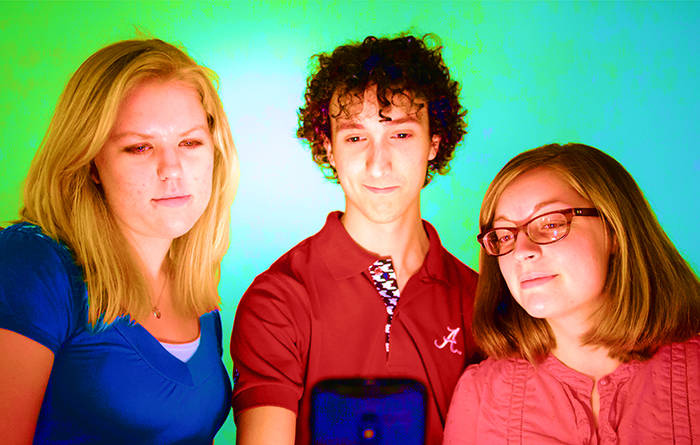
From left to right: Cassidy Lamm, Joshua Wolfe and Lauren Lambert put their smartphone app through a test run.
Cassidy Lamm met Lauren Lambert in her high school freshman English class in Huntsville, Alabama. The two became fast friends, taking most of the same classes and even taking leadership roles in one of the school’s service organizations. Then they became friends with Joshua Wolfe, a grade below them. All three planned to attend The University of Alabama.
This story may not sound extraordinary, but what happened once they arrived at UA is.
“It just happened to work out that we were best friends who got to work on research together,” said Lamm, though they never would have thought it.
During high school Lambert volunteered for Dance Your Dreams, a performing arts center for children with special needs. She was interested in childhood development and decided to study psychology at UA. Lamm, on the other hand, had long been interested in math and science, so she chose computer science.
“I saw the announcement for a specific call for book chapters in the same area as this app and thought ‘this is the perfect fit. Very rarely do you get that kind of gift handed to you, so I just knew we had to go through this.”
– Dr. Jeff Gray, professor of computer science
Not long after they started classes at the University, Lamm and Lambert received an email inviting them to join the Emerging Scholars program, which provides research opportunities to eligible freshman students. They were both eager to gain research experience, but, with their career interests so radically different, they didn’t think they’d be able to work together. It seemed that, for the first time since high school, their work would separate them.
After signing up for the program, they each chose to work with a professor whose research interests mirrored their own. Lamm signed on to work with Dr. Jeff Gray, a professor of computer science who researches software modeling, domain-specific languages and mobile computing. Gray, who also works with United Cerebral Palsy in Birmingham, suggested that Lamm begin her research by helping develop a smartphone application for children with autism spectrum disorders (ASD).
Meanwhile, Lambert had signed on to work with Dr. Angela Barber, assistant professor of communicative disorders. Barber’s research focuses specifically on early intervention methods for children with ASD. When Dr. Ann Webb, director of the Emerging Scholars Program, found out about Lamm’s app-building project for children with autism, she immediately thought of pairing the students together.
“Lauren has a passion to help children with special needs, and her mentor, Dr. Angela Barber, agreed that we should work together as a team,” Lamm said.
The following year, Wolfe started classes at UA and signed on to join Emerging Scholars too. Since he also studies computer science with an interest in mobile-app development, he was able to join the pair.
By that time, Lambert had taken several psychology courses on early childhood development. Her coursework encouraged her to figure out a way to help children with ASD recognize emotions in others. The team agreed to pursue the goal for their app project.

The students began developing a smartphone app targeted toward children around kindergarten age. They wanted the app to have an interactive learning style, so they organized it into three phases. First, the child is presented with an image of a facial expression.
“It may be a picture of someone expressing a happy emotion or smiling, and then it will say the word ‘happy,’” Lambert explained.
The app features an audio option and, after either reading or listening to the name of the corresponding emotion, the child is asked to match the emotion expressed in the image with its correct name. Afterward, the child can participate in an interactive charades phase.
“The ideal setting to use this app would be in a support group, like in a kindergarten or preschool classroom, so the teacher facilitates the charades phase,” Lambert said. In this phase, each child takes a turn and shows an emotion to the group. The other children guess what emotion is being demonstrated.
Based on Barber’s own research studies, the students’ project follows a growing trend of using social media technology in developmental intervention. Last year, Gray received information about an academic publication on the role of technology in autism intervention.
“I saw the announcement for a specific call for book chapters in the same area as this app and thought ‘this is the perfect fit,’” Gray said. “Very rarely do you get that kind of gift handed to you, so I just knew we had to go through this.”
According to Gray, it is rare for undergraduate students to publish at this level. “I have PhD students who would love to have a book chapter in their publications list,” he said. “This is atypical for undergrads to be writing book chapters.”
The book chapter, titled “Improving Socialization and Emotion Recognition for Children with Autism Using a Smartphone App,” is written in collaboration with Barber, Gray and Dr. Gary Edwards, executive director of United Cerebral Palsy of Greater Birmingham. The chapter was published in “Innovative Technologies to Benefit Children on the Autism Spectrum” by Nava Silton, assistant professor of psychology at Marymount Manhattan College. The book was released in spring 2014.
“I think people are really excited to use technology to help their kids,” Lambert said. “Anybody who has small children wants them to have the most advantage that they can, so they’re going to be looking for this.”
A version of this article appeared in the Undergraduate Magazine, published by the The University of Alabama’s Office of Academic Affairs in conjunction with University Relations.
Judah Martin is a journalism major at The University of Alabama. He is from Foley and serves as a student writer for the College of Engineering.